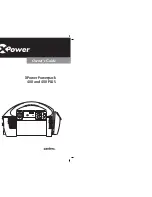
14
| English
1 609 92A 2MG | (18.4.16)
Bosch Power Tools
Utility Hook (see figure D)
Your tool is equipped with a utility hook
6
for hanging it, e.g.,
to a ladder, etc. Simply fold out the utility hook
6
to the re-
quired position.
When the tool is hanging by the utility hook, ensure
that the saw blade is protected against unintended
contact. Danger of injury.
Fold the utility hook
6
back in again when you are ready to
continue working.
Starting Operation
Observe correct mains voltage! The voltage of the pow-
er source must agree with the voltage specified on the
nameplate of the machine. Power tools marked with
230 V can also be operated with 220 V.
The “PowerLight”
10
is lit when the mains plug is inserted,
and allows for illumination of the working range under unfa-
vourable light conditions.
Switching On and Off
To
start
the machine,
first
push the lock-off button for the
On/Off switch
8
and
then
press the On/Off switch
7
and keep
it pressed.
To
switch off
the machine, release the On/Off switch
7
.
Note:
For safety reasons, the On/Off switch
7
cannot be
locked; it must remain pressed during the entire operation.
To save energy, only switch the power tool on when using it.
Orbital action
To achieve a high cutting speed, the orbital action is continu-
ously in operation.
Constant Electronic Control
The constant electronic control keeps the stroke rate almost
constant at no-load and under load, and ensures uniform
working performance.
Controlling/Presetting the Stroke Rate
Increasing or reducing the pressure on the On/Off switch
7
enables stepless stroke-rate control of the switched-on ma-
chine.
Light pressure on the On/Off switch
7
results in a low stroke
rate. Increasing the pressure also increases the stroke rate.
The required stroke rate is dependent on the material and the
working conditions and can be determined by a practical trial.
Reducing the stroke rate is recommended when the saw
blade engages in the material as well as when sawing plastic
and aluminium.
Working Advice
Before any work on the machine itself, pull the mains
plug.
Tips
When sawing light building materials, observe the stat-
utory provisions and the recommendations of the ma-
terial suppliers.
Check wood, press boards, building materials, etc. for foreign
objects such as nails, screws or similar, and always use the
correct sawblade.
Switch the machine on and guide it toward the workpiece.
Position the footplate
2
onto the surface of the work and saw
through the material applying uniform contact pressure and
feed. After completing the working procedure, switch the
machine off.
If the saw blade should jam, switch the machine off immedi-
ately. Widen the gap somewhat with a suitable tool and pull
out the machine.
Plunge Cutting (see figure E)
The plunge cutting procedure is only suitable for treat-
ing soft materials such as wood, plaster board or simi-
lar! Do not work metal materials with the plunge cut-
ting procedure!
Use only short saw blades for plunge cutting.
Place the machine with the edge of the footplate
2
onto the
workpiece and switch on. For power tools with stroke speed
control, set the maximum stroke speed. Press the power tool
firmly against the workpiece and allow the saw blade to slowly
plunge into the workpiece.
As soon as the footplate
2
fully lays on the surface of the work-
piece, continue sawing alongside the desired cutting line.
For certain work, the saw blade
1
can also be inserted turned
through by 180° and the sabre saw can be guided accordingly
in a reversed manner.
Flush Cuts (see figure F)
Using elastic bimetal saw blades, items still attached to a wall
(e.g. projecting building elements such as water pipes, etc.)
can be sawn off flush at the wall.
Pay attention that the saw blade always extends be-
yond the diameter of the material being worked. There
is danger of kickback.
Position the saw blade directly against the wall and apply
some lateral pressure via the tool until the footplate faces
against the wall. Switch the power tool on and saw through
the workpiece, applying constant lateral pressure.
Coolant/Lubricant
When sawing metal, coolant/lubricant should be applied
alongside cutting line because of the material heating up.
Maintenance and Service
Maintenance and Cleaning
Before any work on the machine itself, pull the mains
plug.
For safe and proper working, always keep the machine
and ventilation slots clean.
Clean the saw blade holder preferably with compressed air or
a soft brush. Remove the saw blade from the power tool for
this. Ensure proper operation of the saw blade holder by ap-
plying a suitable lubricant.
Heavy contamination of the machine can lead to malfunc-
tions. Therefore, do not saw materials that produce a lot of
dust from below or overhead.
If the replacement of the supply cord is necessary, this has to
be done by Bosch or an authorized Bosch service agent in or-
der to avoid a safety hazard.
OBJ_BUCH-1366-006.book Page 14 Monday, April 18, 2016 5:06 PM















































